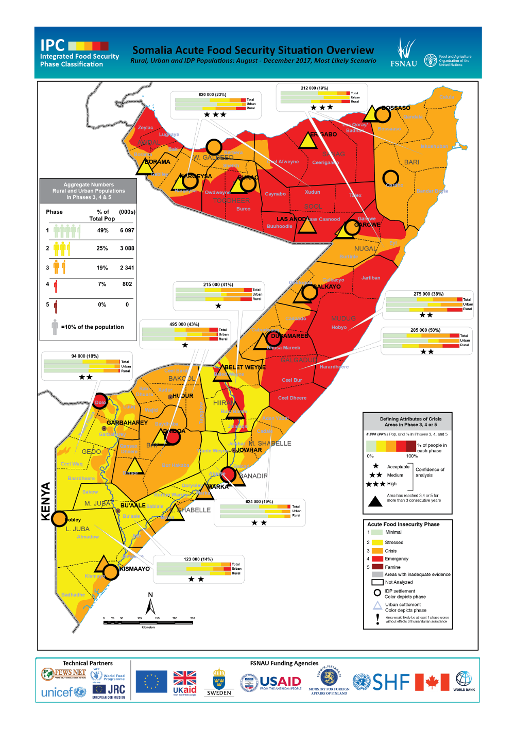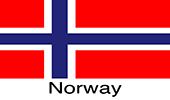FSNAU-FEWS NET 2017 Post Gu Technical Release Final - 31 Aug 2017
Issued: August 31, 2017
With 3.1 million people facing crisis and emergency, acute food insecurity persists in Somalia
Acute malnutrition Increases and risk of Famine continues
August 31, 2017, Mogadishu/Washington – An estimated 3.1 million people, 25 percent of the population, are expected to be in Crisis (IPC Phase 3) or Emergency (IPC Phase 4) through December. The Gu (April-June) cereal harvest was far below average, prices of local cereal remain well above average, and substantial livestock losses have occurred, all of which have lowered household access to food and income. Persistent drought has led to large-scale population displacement. Deyr (October-December) rains are expected to be average to below average, but levels of acute food insecurity in Somalia will remain high through the end of the year. Acute and widespread food insecurity and increased morbidity have contributed to further deterioration of the overall nutrition situation in Somalia. Scaled up humanitarian assistance must be sustained in order to prevent further deterioration of food security and nutrition situation of the affected population. A risk of Famine continues through the end of the year in the worst affected areas: in a worst-case scenario where there is a significant interruption to current food assistance programs and higher prices further decrease household food access. Areas of greatest concern include the northeast and some IDP populations. 
The 2017 Gu rains started late, ended early and were below average in most parts of Somalia. The Gu season cereal harvest, which is estimated at 78 400 tonnes, is 37 percent lower than the long-term (1995-2016) average. Gu/Karan cereal production in northwest Somalia is estimated at 6 500 tonnes, 87 percent lower than the 2010-2016 average. As a result, poor households in crop-dependent livelihood zones of the northwest and southern Somalia have little or no food stocks. Farm labor opportunities were also limited. In pastoral areas affected by protracted and persistent drought, livestock production and reproduction have declined sharply. Depletion of livestock assets due to distress sales and mortality has contributed to increased indebtedness and destitution among many pastoralists. As a result, most rural livelihood zones of Somalia are classified as Crisis (IPC Phase 3) or Emergency (IPC Phase 4).
Findings from a seasonal assessment conducted across Somalia in June and July 2017 indicate that over 3.1 million people will face Crisis or Emergency (IPC Phases 3 and 4)1 through December 2017. This represents only a slight improvement in food security compared to the figures projected for April-June 2017, primarily as a result of sustained humanitarian assistance and improved rainfall in localized areas. Additionally, nearly 3.1 million people are classified as Stressed (IPC Phase 2). In total, 6.2 million people across Somalia face acute food insecurity. This seasonal assessment was jointly led by the Food Security and Nutrition Analysis Unit for Somalia (FSNAU, a project managed by the Food and Agriculture Organization of the United Nations), and the Famine Early Warning Systems Network (FEWS NET, a project funded by USAID) and carried out with the active participation of Government institutions and other partners.
The overall nutrition situation in Somalia has continued to deteriorate, especially in northern and central parts of Somalia. Results from 31 separate nutrition surveys conducted FSNAU and partners between June and July 2017 indicate that an estimated 388 000 children under the age of five are acutely malnourished, including 87 000 who are severely malnourished and face an increased risk of morbidity and death. In two-thirds of the 31 nutrition surveys conducted, Global Acute Malnutrition (GAM) prevalence were considered Critical (15-30%) or Very Critical (>30%). In one-thirds of the surveys, Severe Acute Malnutrition (SAM) was also considered Critical (≥4.0-5.6%) or Very Critical (>5.6%). Morbidity rates are at least 20 percent or higher in more than half of the surveyed populations, contributing to the reported high levels of acute malnutrition in most of these populations. Mortality rates have also increased. Crude Death Rates (CDR) and/or Under-Five Death Rate (U5DR) have surpassed emergency thresholds in seven of the population groups surveyed (i.e. CDR > 1/10 000/day and U5DR > 2/10 000/day, respectively).
Over 701 500 people were displaced due to drought in the first half of 2017. With limited livelihood and coping options and poor living conditions, exacerbated by recent large-scale displacement due to drought, food security and nutrition outcomes across most of the 13 main settlements for internally displaced persons (IDPs) indicated a deterioration. Accordingly, most of the IDP settlements are classified as Crisis (IPC Phase 3) or Emergency (IPC Phase 4). Impacted by high food prices, increased completion from displaced populations and localized trade disruptions, poor households in some of the major urban areas of the country face acute food security Crisis (IPC Phase 3).
A large-scale humanitarian intervention has taken place in the first half of 2017 in response to the ongoing drought. According to the Somalia Food Security Cluster, emergency humanitarian assistance is reaching roughly 2.5 million people a month since April. Results from the post-Gu analysis indicated that humanitarian assistance is preventing further deterioration in many areas and is having a significant impact in several northeastern areas.
Recent climate forecasts from IGAD’s Climate Prediction and Application Center (ICPAC) indicate average to below average rainfall, with decline of rainfall during the peak rainfall month of November, to prevail across most parts of Somalia during the forthcoming 2017 Deyr (October-December) season. The forecast also indicates a warmer than normal temperature over the same period across most parts of the country. The combined impact is expected to lead to faster depletion of pasture and water sources and cause retarded crop development due to moisture stress.
Approximately 388 000 acutely malnourished children need urgent treatment and nutrition support, including 87 000 who are severely malnourished. Over 3.1 million people in Crisis and Emergency (IPC Phases 3 & 4) urgently need scaled up, sustained and integrated life-saving humanitarian assistance and livelihood protection support in order to prevent further food security deterioration. Livelihood protection and support is needed for nearly 3.1 million additional people who are Stressed (IPC Phase 2).
Areas and Populations of Concern
Populations groups classified as Crisis and Emergency (IPC Phases 3 & 4) require interventions aimed at reducing food consumption gaps, reducing acute malnutrition, saving lives and protecting and saving livelihoods.
Region of Somalia | Total Population (2014 Estimates) | Number of Acutely Food Insecure People (August-December 2017) | ||
Stressed (IPC 2) | Crisis (IPC 3) | Emergency (IPC 4) | ||
Awdal | 673,264 | 132,000 | 105,000 | 36,000 |
Woqooyi Galbeed | 1,242,003 | 438,000 | 114,000 | 36,000 |
Togdheer | 721,363 | 202,000 | 125,000 | 46,000 |
Sanaag | 544,123 | 133,000 | 127,000 | 88,000 |
Sool | 327,427 | 82,000 | 98,000 | 45,000 |
Bari | 730,147 | 240,000 | 80,000 | 25,000 |
Nugaal | 392,698 | 71,000 | 73,000 | 34,000 |
Mudug | 717,862 | 152,000 | 221,000 | 54,000 |
Galgaduud | 569,434 | 110,000 | 212,000 | 73,000 |
Hiraan | 520,686 | 108,000 | 156,000 | 59,000 |
Middle Shabelle | 516,035 | 164,000 | 46,000 | 0 |
Lower Shabelle | 1,202,219 | 341,000 | 134,000 | 0 |
Banadir | 1,650,228 | 358,000 | 307,000 | 137,000 |
Bay | 792,182.0 | 120,000 | 245,000 | 79,000 |
Bakool | 367,227 | 51,000 | 114,000 | 57,000 |
Gedo | 508,403 | 157,000 | 87,000 | 7,000 |
Middle Juba | 362,921 | 98,000 | 30,000 | 0 |
Lower Juba | 489,307 | 131,000 | 67,000 | 26,000 |
TOTAL | 12,327,529 | 3,088,000 | 2,341,000 | 802,000 |
The following population groups have Critical prevalances of acute malnutrition (Global Acute Malnutrition (GAM) Weight-for-Height (WHZ) prevalence of 15 % or higher) and are considered hotspots in need of urgent nutrition and health support interventions:
-
Rural livelihoods: Guban Pastoral, Northern Inland Pastoral of northwest and northeast, Hawd Pastoral of northwest and northeast, Coastal Deeh Pastoral and Fishing of northeast, Shabelle Agropastoral, Bakool Pastoral, North Gedo Pastoral and North Gedo Riverine;
-
IDP populations: Hargeysa, Berbera, Qardho, Garowe, Galkacyo, Dhusamareb, Mogadishu, Baidoa, Dollow and Kismayo.
FSNAU and FEWS NET will continue to monitor conditions and outcomes and report on the situation. More detailed reports on the Post-Gu assessment and the outlook through December will be published in September. All information will be made available through www.fsnau.org and www.fews.net.
Download : FSNAU-FEWS NET 2017 Post Gu Technical Release Final - 31 Aug 2017 (484KB)
For more information, please contact: Chi Lael, Communications Officer, Tel: +254 -739469107, Email: chi.lael@fao.org and Marie Maroun, Communications officer, Famine Early Warning Systems Network (FEWS NET), Tel: +1 202 524 7749, Email: mmaroun@fews.net
1 The Integrated Food Security Phase Classification (IPC) is a set of tools and procedures to classify the severity of food insecurity using a widely accepted five-phase scale. At the area level, it divides areas into the following phases: IPC Phase 1=Minimal; Phase 2=Stressed; Phase 3=Crisis; Phase 4=Emergency; and Phase 5=Famine.


















